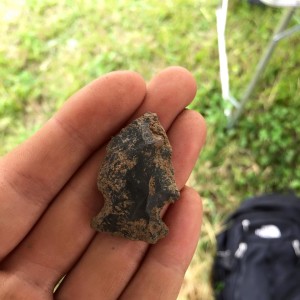 As Jamie and Adam from the Mythbusters taught us, the only difference between science and goofing off, is writing it down. Doing paperwork while in the field is extremely important! Without it our fellow archaeologists would have no idea which level certain artifacts came from or at what level the soil changed. Both of these facts are vital to better understanding the site that’s being researched. And both of these facts, along with many others, can be cataloged on the multiple forms good archaeologists keep with them while out in field. One of the forms we have here at the Carter Robinson Mound is a Test Unit form.
As Jamie and Adam from the Mythbusters taught us, the only difference between science and goofing off, is writing it down. Doing paperwork while in the field is extremely important! Without it our fellow archaeologists would have no idea which level certain artifacts came from or at what level the soil changed. Both of these facts are vital to better understanding the site that’s being researched. And both of these facts, along with many others, can be cataloged on the multiple forms good archaeologists keep with them while out in field. One of the forms we have here at the Carter Robinson Mound is a Test Unit form.
Test Unit forms contain all of the site information; including the site number, the test unit number (which is the southwest coordinate), the initials of who is excavating, and what level is being excavated. It’s important to record what level is being excavated because the types of artifacts found can provide information about the previous inhabitants. Each level might contain different artifacts and it is useful to know from which level they came from. Another section on the Test Unit form is for soil descriptions, the soil can tell archeologists if a structure used to exist there. For example, say there is a darker area in the south east corner of the test unit. Archaeologists would then take a Munsell test (a test that involves matching the soil color to a textbook color) and then feel the texture of the soil and note both on the Test Unit form. Writing down this information allows for other archaeologists to keep a look out for that dark spot in deeper levels, if the dark spot is still present this could be a possible post hole! Post holes are essential to identifying  previously existing structures. Below the soil description is a section for writing the artifact content and density. Here archaeologists record what types of artifacts they find, such as flakes, projectile points, or pottery. Then they note if there is a low, medium, or high density of that specific artifact for that specific level.
previously existing structures. Below the soil description is a section for writing the artifact content and density. Here archaeologists record what types of artifacts they find, such as flakes, projectile points, or pottery. Then they note if there is a low, medium, or high density of that specific artifact for that specific level.
With all of this information on just one form, it can take up some time while out in the field. However, paperwork is essential for the job. Paperwork, when filled out correctly, keeps everything organized and allows for everything to run smoothly when it is time to return to the lab!